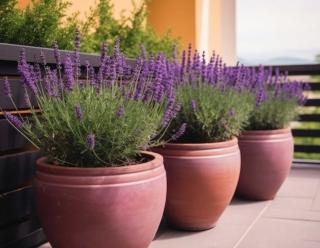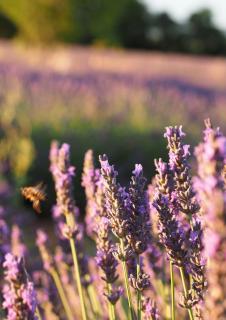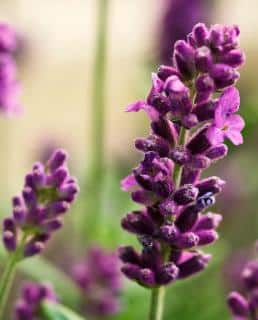

Lavandula angustifolia is the scientific name of common lavender. It’s grown both in gardens and in large fields.
Lavandula angustifolia facts
Name – Lavandula angustifolia
Family – Lamiaceae
Type – herbaceous shrub
Height – 2 to 4 feet (0.6 to 1m)
Exposure – full sun
Soil – very well-drained, ordinary to alkaline
Foliage – evergreen – Flowering – Summer
Learn how to care for Lavandula angustifolia in the garden and in containers for fragrant violet blooms.
Read also:
Although it can cope with slightly acidic soil, best is to plant lavender in neutral or alkaline ground.
Plant either in fall or spring preferably. If it doesn’t freeze, it’s also possible to plant in winter.
It’s actually more difficult to grow common lavender in a container than it is in the ground.
Indeed, potted plants are more vulnerable both to under- and over-watering.

Crucial point is to make sure the mix drains well. A bottle of water poured into the pot filled with soil mix should drain out the bottom within seconds.
Apart from that, though, your Lavandula angustifolia will only rarely need any fertilizer.
 Usually cuttings are used to prepare new specimens.
Usually cuttings are used to prepare new specimens.
Seeds and simply splitting the bunch in two also work well.
For professional purposes, micro-propagation is generally applied.
The less this lavender is watered, the stronger its essential oils will be. To have a very fragrant plant, don’t water at all!
Only upon planting and perhaps only during extreme droughts after that should the plant be watered (except for container growing).
Make your own fermented weed fertilizer as a more natural and affordable solution!
For some varieties, deadheading – removing spent flowers – will trigger a second round of blooming.
L. angustifolia cannot take severe pruning. You must always prune on recently grown wood.
Prune at the end of winter.
With proper soil structure that drains well, the chances of your L. angustifolia contracting disease are slim.
Root rot, on the other hand, is very common. It is the direct result of overwatering and poorly draining soil.
However, you needn’t fear caterpillars nor aphids: this plant repels them well, even if some white butterflies love to drink its nectar!
There are a great many L. angustifolia varieties. They vary in size, color, fragrance and hardiness.
The main ones found in horticulture stores are the ‘Hidcote’, ‘Munstead’ and ‘Melissa’ varieties.
Of course, one must also mention the many hybrids that are collectively classified as L. x intermedia.
 Early on, ancient Pharaohs were embalmed using Egyptian lavender, and since then all peoples and tribes of the Mediterranean have grown it for health, cooking and beauty.
Early on, ancient Pharaohs were embalmed using Egyptian lavender, and since then all peoples and tribes of the Mediterranean have grown it for health, cooking and beauty.
Its fragrance and clean, round shape is why laundry cleaners of old would spread cleaned linens and clothing atop it to dry. This gave these women their title: “les lavandières“!
Lavandula angustifolia is native to the Northern half of that small ocean, in locations that are extremely rocky and dry. The concentration of essential oils helped the plant defend itself against pests and diseases, and the fragrance attracts pollinators from very far away!
Today, it is the variety of lavender most cultivated and grown for its extracts. In recent times, this hardy variety was prized by English perfume makers and landscapers, leading to a new common name for the species: English lavender.
Drainage is the key to keeping your Lavandula alive. Make sure water can seep away before it starts rotting the roots!